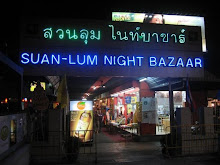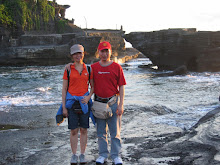By Catherine Beale
I wanted to pass on the details of an excellent long weekend
that we spent as a family in East Malaysia. My husband, two
sons (aged 5 and 3 years) and I visited Kuching, the capital of
Sarawak in Eastern Malaysia. It is a gem of a sleepy town,
with plenty to occupy your family for a couple of days and
perfect for when you’ve had enough of beach resorts for a
while. Accommodation and transport is easy and it has an
interesting recent history under the control of the ‘White
Rajahs’. The ethnic mix includes tribal Dayaks and a high
percentage of Chinese which gives the compact town a
different feel to Peninsular Malaysia, without being too
startlingly different. An added bonus is that Air Asia and
Malaysia Airlines offer reasonable flights. We stayed at the
Crowne Holiday Inn right on the river, although there are many
other hotels to choose from. We made life mentally even
simpler by befriending Jemat a taxi driver from outside the
hotel, for all our day trips.
Our holiday coincided with the Buddhist festival of Wesak in
May. At night the streets beneath our hotel room were
filled with an endless parade of spooky crowds bearing candles
and singing. The people were grouped according to their temple/
clan and followed slow moving, lit floats carrying ‘themed’
Buddhas. But our holiday had many more sights in store.
We had been advised to go to the Sarawak Cultural Village
and it proved better than it sounds. The ½ hour taxi journey
left the outskirts of Kuching and passed through apparently
empty countryside. The small, undulating road was banded
on either side by power lines covered in kingfishers. The village
itself is made up of reconstructions of homes belonging to
every tribal and ethnic group in the region; Bidayuh and Iban
longhouses, tall houses on top of immense poles, even Malay
kampong houses. Limestone cliffs rise up sharply behind the
circuit of buildings and boulders, topped by jagged, forested
peaks. As we approached the central lake we saw technicians
busily setting up equipment for the International Rainforest
Music Festival which the village hosts each year. The children
were happy to scramble up and down ladders, explore head
men’s huts, grind rice and try using a blow pipe; which was
surprisingly easier than we thought. They had been given a
‘passport’ to be stamped at each building which made them
very happy.
The next day we were up early and were driven about forty five
minutes outside of town to the stilted fishing village of Kampong
Bako, our jumping off point to the mouth of the Bako River
and park beyond. On our arrival we could smell a mixture of
drying fish and mud. Crates of horse-shoe crabs and rays on
ice lined the road. The feel of the place was very different later
that day when the high tidal water lapped up underneath the
houses, obliterating the mangrove shoots and refuse beneath.
We tried to pay our park entry fee at a small kiosk at the
dock; however we discovered that it was Bako Day and so
entry was free. We paid for our boat to the park, plus a donation
and soon we were reverberating down the widening river.
Our motorised fishing boat was fast and we flashed past silted
mangrove and saw a couple of fish eagles before nudging into
the silent, shallow beach at Bako Park HQ. The right hand
side of the beach is backed by weirdly moulded rock cliffs
which are studded with bat caves; the left hand side of the
beach ends in mangrove. At its centre lies a grassy area and
the park HQ buildings. Bako Day was beginning to attract a
large number of local site-seers but our fears that they would
scare off the wildlife were unfounded; two giant hairy pigs
greeted us at the bins. Most people didn’t venture far from the
office and restaurant, maybe hoping to be caught on camera
by the visiting local press or just hanging out to get a slice of
the creamy Bako birthday cake on offer. We consulted our
basic map that we had been given decided to take a shortish
walk called Paku, which would take us into the interior and
onwards to a lookout further around the coast. We would walk
as far as the children were able and hunt for Proboscis
Monkeys.
Kuching Long House at Sarawak Cultural Village
The long, high boardwalks above the mangrove caused great
excitement as they were alive with crawling shells of various
crustaceans. The path then rose sharply into the jungle and
the boys were scrambling over roots, up short, mossy, wooden
ladders, past small waterfalls and the shoulders of huge tree
trunks. We managed to find two monkeys and enjoyed their
crunching progress through the trees before another party’s
noisy arrival scared them away. With their attention held, the
kids lasted a miraculous four hours walking in the park.
climb on a beautifully made wooden climbing area, complete
with fishing boat and giant sea creatures.
Our final morning was reserved for Sarawak’s must see
orangutans. We drove out with Jemat to the Semenggok
Wildlife Rehabilitation Centre for orphaned and rescued
orangutans and made it for the first feed at 8.30am when you
are most likely to see them. On arrival we were briefed about
what to expect and how to behave so that the park can
Back in Kuching we were happy to still have the afternoon to
wander around the compact town. Kuching is mainly on the
South side of the Sarawak River and its river front has a modern
walk-way which is studded with steps down to the water from
where you can hire boats or catch a small ferry to the other
side. It is still customary to leave the few sen fee behind you
on your wooden seat. After drinks and ice creams we crossed
to the fort built by the second ‘White Rajah’ ruler Charles
Brooke to guard the river. It is named after his wife, Margherita,
and consists of a pretty white crenellated tower which features
a crest above the huge arched door, a bell and a murderous
history. We approached it by foot through a small kampong
which looked like it was constructed at the same time.
Unfortunately we found the door to the fort locked and the
parade ground outside empty. We left the fort from an ancient
looking quay near to the beautiful Istana. Charles Brook was
also responsible for this white edifice; consolidating his Uncle
James Brooke’s new dynasty.
continue its work of returning the orangutans to the wild. A
narrow path took us through the trees a short way to an
observation post near a feeding platform containing fruit and
vegetables. My husband’s trip highlight followed as a huge,
male orangutan smashed and cracked his way towards us
through the tree canopy to his breakfast. Later he retreated
and was replaced by a mother and baby. Returning to the
orphanage we saw several tamer mothers and babies. There
was just time to look pityingly at the few crocodiles that they
had caged in the back, before returning to the hotel and then
to the airport.
Back in the main town we wandered past the former jail in the
Square Tower and the historic market building. We passed
the tribal souvenir shops along the quaint shophouse street of
Jalan Carpenter. By now we were overdue dinner and so we
returned to the riverside walk and park and were seated in
Brooke Café. Lights in the trees were coming on and we
ordered cold beers on the terrace which looked out over a
small lawn studded with bronze statues of cats. ‘Kuching’
means cat in Bahasa and the boys petted and sat on the
backs of the metal kittens while we watched the sunset over
the river and ate our ‘fusion cuisine’ (a word of warning; the
café’s toilets were among the worst I’ve ever encountered). In
the gathering dusk we moved to a bench to watch the boys
All our journeys had been short, bite-sized half hour chunks
and the short flight also made the holiday very relaxing.
Everyone we met was extremely welcoming and happy to
see us visiting their town, and as usual in SE Asia we’d had
no trouble finding good food whenever we grew hungry. One
day we may return to see Kuching’s world class Sarawak
Museum complete with the naturalist Wallace’s famous
collection of tribal artifacts and natural history. The display
includes an antique watch rescued from a crocodile’s stomach.
The Rainforest Music Festival is also worth seeing without
kids. Now that we’re back to KL Life, our trip has given us a
valuable new perspective on Malaysia. It’s nice to remember
that elsewhere in our adopted country lies pretty Kuching
steeped in its rich history, culture and natural environment.








